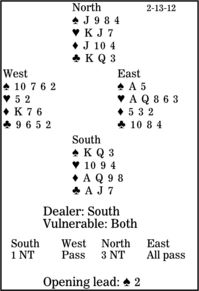Bridge column, February 13: The impulse must be resisted

That is not true at the bridge table, where even longtime competitors often rely on the plays that have held them in good stead over the years. However, every now and then a deal comes along in which the "textbook" play does not work -- as in this example.
How should East plan the defense against three no-trump after West leads a fourth-highest spade two?
North sensibly decided not to use Stayman with 4-3-3-3 distribution and a hand that suggested no-trump rather than a suit contract.
The textbook advises returning partner's suit when you are in no-trump. And that will be best most of the time. But when the opponents have more cards in the suit than your side, it will usually be better to direct your attack elsewhere.
In this deal, if East wins with his spade ace and returns his second spade, South will take the trick, cross to dummy with a club, and run the diamond jack. West can win and shift to a heart, but the defenders take only four tricks: one spade, two hearts and one diamond.
East should expect his partner to have one entry card. And if West also holds at least two hearts, the contract can be defeated by a low-heart shift at trick two.
This works perfectly. When South tries for his contract by taking the diamond finesse, he goes down two. (Yes, he could cash his eight tricks: three spades, one heart, one diamond and three clubs. But that would be defeatist.)
** ** **
COPYRIGHT 2012, UNITED FEATURE SYNDICATE
DISTRIBUTED BY UNIVERSAL UCLICK FOR UFS

